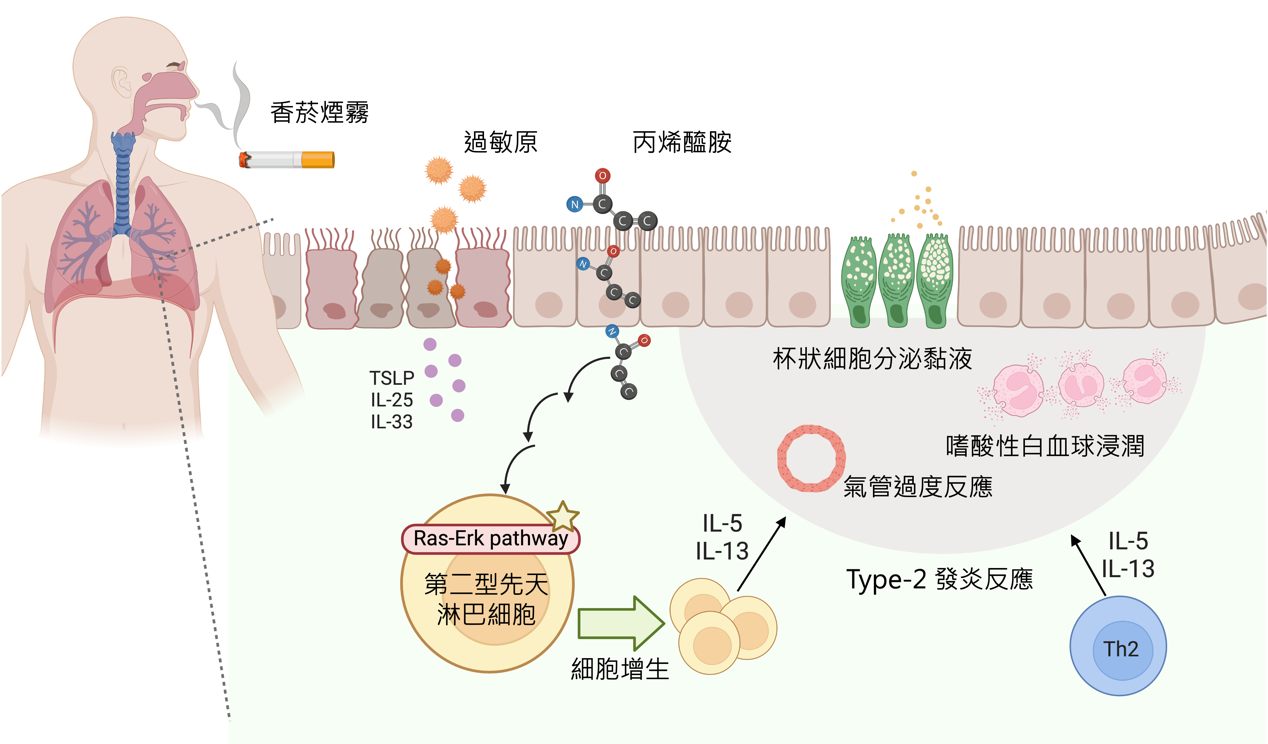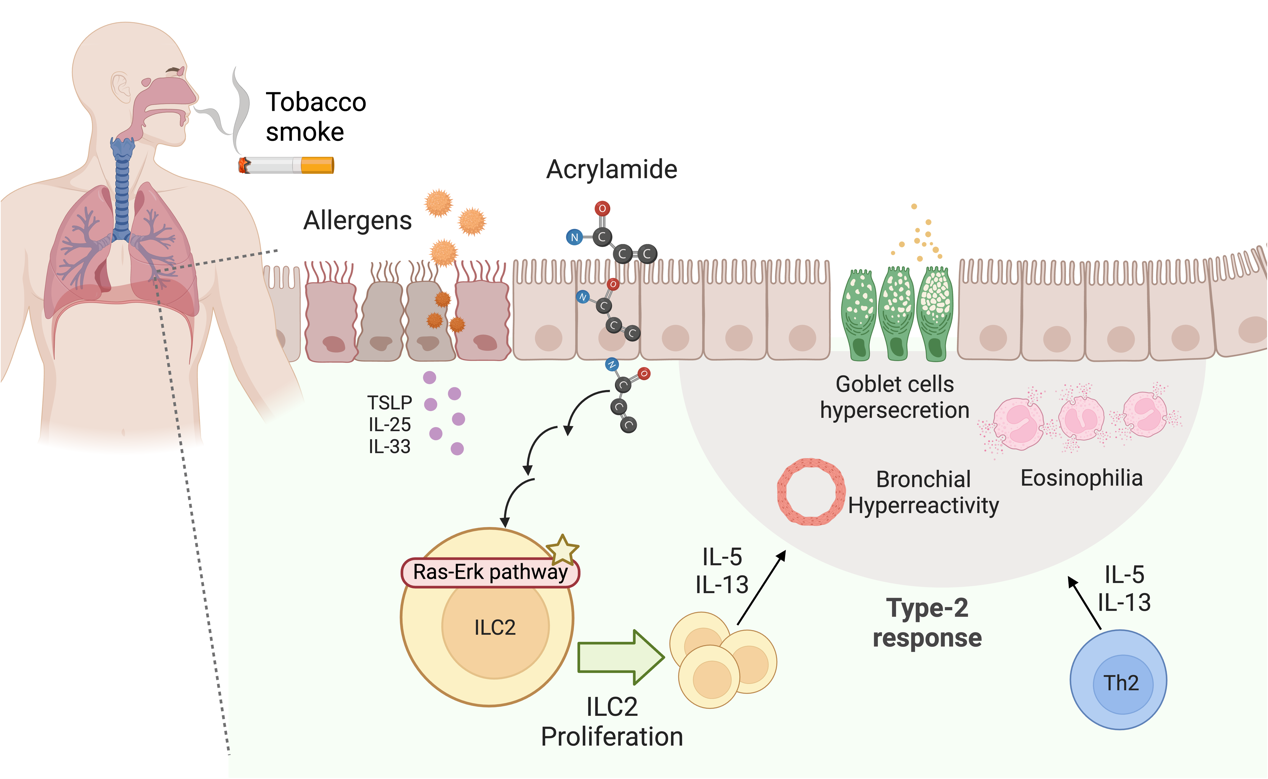空氣污染物質丙烯醯胺會透過第二型先天淋巴細胞加重過敏原誘導的嗜酸性白血球肺部發炎
空氣污染物質丙烯醯胺會透過第二型先天淋巴細胞加重過敏原誘導的嗜酸性白血球肺部發炎
丙烯醯胺是什麼?
丙烯醯胺廣泛應用於食品加工、紙製品製造和污水處理等,實驗室中所常用的西方點墨法也會使用丙烯醯胺為原料,在許多食物中也存在天然的丙烯醯胺,主要是在烘烤、油炸過程中,食物中的氨基酸和還原糖在高溫下發生「梅納反應」而形成丙烯醯胺,此外空氣中也有丙烯醯胺存在,尤其是香菸煙霧中濃度較高。
丙烯醯胺對我們有什麼影響?
丙烯醯胺會經由皮膚接觸、食物、還能以空氣污染物質的方式被吸入,吸入丙烯醯胺已知對人體具有神經毒性,人體流病資料雖然尚未證實丙烯醯胺在人體的致癌性,卻點出丙烯醯胺與過敏相關症狀具有顯著相關性,但吸入丙烯醯胺對人體免疫系統的影響仍然是未知。
什麼是嗜酸性白血球肺部發炎?
嗜酸性白血球在人體對抗寄生蟲和過敏反應中扮演重要角色,然而,當嗜酸性白血球過度活躍,浸潤到組織當中釋放發炎物質,就會導致發炎反應,會誘導嗜酸性白血球浸潤的其中一個細胞激素為Interleukin-5 (IL-5),主要由T helper 2 (Th2)及第二型先天淋巴細胞 (Group 2 innate lymphoid cell; ILC2) 所分泌,嗜酸性白血球肺部發炎在氣喘患者中非常常見,當這類氣喘患者接觸到過敏原(如黴菌、花粉、動物毛髮)時,免疫系統的過度反應會造成肺部發炎、氣管過度反應,進而導致呼吸困難等症狀。
本研究的目的是?
在過敏性肺部發炎情況下,探討吸入的丙烯醯胺對肺部發炎的免疫影響和機制。
我們發現了什麼?
本研究發現,小鼠經由鼻腔暴露低劑量丙烯醯胺後,會加重由過敏原引起的嗜酸性白血球肺部發炎,嗜酸性白血球浸潤增加,機制主要是透過丙烯醯胺會增加ILC2細胞增生。在缺乏T、B細胞的小鼠 (Rag1-/-) 中也觀察到相同的現象,且經由adoptive transfer丙烯醯胺處理後的ILC2,也發現肺部沖洗液中嗜酸性白血球的顯著增加,顯示了ILC2在丙烯醯胺反應中的重要性。
吸入丙烯醯胺會增加肺部發炎告訴我們什麼?
本研究證實,空氣中的丙烯醯胺可能對有過敏性疾病的族群,特別是過敏性氣喘患者,帶來額外的健康風險,提醒我們要更加重視環境中空氣污染物質可能帶來的影響,這項研究也為未來治療過敏性疾病提供了新的思路。
圖形摘要

應用與亮點:
1.低濃度的丙烯醯胺經由鼻腔吸入會加重過敏原誘導的嗜酸性白血球肺部發炎
2.丙烯醯胺會直接促進ILC2細胞增生
3.丙烯醯胺會透過活化ILC2的Ras-Erk訊息傳遞路徑來促進細胞增生
【研究團隊】
團隊成員:孫昭玲教授、翁子軒博士、蘇湘涵博士
代表單位:精準環境醫學研究中心
團隊簡介:孫教授團隊長期致力於環境污染物慢性暴露對免疫系統的有害影響,期望研究結果能應用於預防氣喘的加重或開發新療法。
研究聯繫Email:jlsuen@kmu.edu.tw
【論文資訊】
論文出處:Mucosal Immunology; 2024 Feb; 17(1): 13-24.
全文下載:https://doi.org/10.1016/j.mucimm.2023.09.007
Acrylamide, an air pollutant, enhances allergen-induced eosinophilic lung inflammation via group 2 innate lymphoid cells
Acrylamide, an air pollutant, enhances allergen-induced eosinophilic lung inflammation via group 2 innate lymphoid cells
What is Acrylamide?
Acrylamide is widely used in food processing, paper manufacturing, and wastewater treatment. In laboratories, it is also a key component in the Western blot technique. Naturally occurring acrylamide is present in many foods, primarily formed during baking and frying processes. This occurs when amino acids and reducing sugars in the food undergo the "Maillard reaction" at high temperatures, leading to the formation of acrylamide. Additionally, acrylamide is also present in the air, with particularly high concentrations found in cigarette smoke.
How does Acrylamide affect us?
Acrylamide can enter the body through skin contact, food, and by inhalation as an air pollutant. Inhalation of acrylamide is known to have neurotoxic effects on humans. Although epidemiological data have not yet confirmed the carcinogenicity of acrylamide in humans, there is significant evidence linking acrylamide exposure to allergic symptoms. However, the impact of inhaled acrylamide on the human immune system remains unknown.
What is Eosinophilic lung inflammation?
Eosinophils play a crucial role in the body’s defense against parasites and in allergic reactions. However, when eosinophils become overactive and infiltrate tissues, releasing inflammatory substances, they can cause an inflammatory response. One of the cytokines that induces eosinophil infiltration is Interleukin-5 (IL-5), which is mainly secreted by T helper 2 (Th2) cells and Group 2 innate lymphoid cell (ILC2). Eosinophilic lung inflammation is common among asthma patients. When these patients are exposed to allergens (such as mold, pollen, or animal dander), an overreaction of the immune system causes lung inflammation and bronchial hyperresponsiveness, leading to symptoms like difficulty in breathing.
What is the purpose of this study?
This study aims to investigate the immunological effects and mechanisms of inhaled acrylamide on lung inflammation in the context of allergic lung inflammation.
What did we discover?
The study found that mice exposed to low doses of acrylamide via nasal inhalation exacerbated eosinophilic lung inflammation induced by allergens, with increased eosinophil infiltration. The mechanism is primarily through acrylamide-enhanced proliferation of ILC2 cells. The same phenomenon was observed in mice lacking T and B cells (Rag1-/- mice), and a significant increase in eosinophils in bronchoalveolar lavage fluid was also noted after adoptive transfer of acrylamide-treated ILC2 cells, indicating the crucial role of ILC2 in the acrylamide response.
What does the increased lung inflammation due to inhaled acrylamide tell us?
This study confirms that acrylamide in the air may pose additional health risks for individuals with allergic diseases, particularly those with allergic asthma. This study not only reminds us to pay greater attention to the potential impact of environmental air pollutants, but also provides new insights for future treatments of allergic diseases.
Graphical Abstract

Application and Highlights:
1.Low-dose acrylamide, an air pollutant, exposure promotes eosinophilic inflammation.
2.Acrylamide directly enhances lung ILC2 proliferative activity.
3.Acrylamide induces proliferation of ILC2s through the Ras-Erk pathway.
Research Team Members:
Prof. Jau-Ling Suen, Tzu-Hsuan Wong, PhD, Hsiang-Han Su, PhD.
Representative Department: Research Center for Precision Environmental Medicine
Introduction of Research Team: Professor Suen's team has long been dedicated to studying the harmful effects of chronic exposure to environmental pollutants on the immune system, hoping that these research findings can be applied to prevent the worsening of asthma or to develop new therapies.
Contact Email: jlsuen@kmu.edu.tw
Publication: Mucosal Immunology; 2024 Feb; 17(1): 13-24.
Full-Text Article: https://doi.org/10.1016/j.mucimm.2023.09.007


